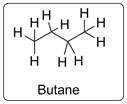
Concept explainers
(a)
Interpretation:
A four carbon molecule must be created which is an alkane.
Concept introduction:
Answer to Problem 4E
Butane is an alkane which has four carbon atoms.
Explanation of Solution

Structure of butane is shown. Molecular formula is C4H10. It follows the general formula of alkanes which is CnH2n + 2.
(b)
Interpretation:
A four carbon molecule must be created which is a carboxylic acid.
Concept introduction:
Carboxylic acids are organic compounds with general formula CnH2nO2.
Answer to Problem 4E
Butanoic acid is a carboxylic acid which has four carbon atoms.
Explanation of Solution

Structure of butanoic acid is shown. Molecular formula is C4H8O2. It follows the general formula of carboxylic acid which is CnH2nO2.
(c)
Interpretation:
A four carbon molecule must be created which is an alcohol.
Concept introduction:
Alcohols are organic compounds with general formula CnH2n + 2O.
Answer to Problem 4E
Butan-1-ol is an alcohol which has four carbon atoms.
Explanation of Solution

Structure of butan-1-ol is shown. Molecular formula is C4H10O. It follows the general formula of alcohol which is CnH2n + 2O.
(d)
Interpretation:
A four carbon molecule must be created which is an ester.
Concept introduction:
Esters are organic compounds (carboxylic acid derivative) with general formula CnH2nO2.
Answer to Problem 4E
Methyl propanoate is an ester which has four carbon atoms.
Explanation of Solution

Structure of methyl propanoate is shown. Molecular formula is C4H8O2. It follows the general formula of carboxylic acid and esters which is CnH2nO2.
Chapter U2 Solutions
Living By Chemistry: First Edition Textbook
Additional Science Textbook Solutions
Organic Chemistry
Chemistry: Structure and Properties
General Chemistry: Atoms First
Chemistry: The Central Science (13th Edition)
Inorganic Chemistry
Chemistry: A Molecular Approach
 ChemistryChemistryISBN:9781305957404Author:Steven S. Zumdahl, Susan A. Zumdahl, Donald J. DeCostePublisher:Cengage Learning
ChemistryChemistryISBN:9781305957404Author:Steven S. Zumdahl, Susan A. Zumdahl, Donald J. DeCostePublisher:Cengage Learning ChemistryChemistryISBN:9781259911156Author:Raymond Chang Dr., Jason Overby ProfessorPublisher:McGraw-Hill Education
ChemistryChemistryISBN:9781259911156Author:Raymond Chang Dr., Jason Overby ProfessorPublisher:McGraw-Hill Education Principles of Instrumental AnalysisChemistryISBN:9781305577213Author:Douglas A. Skoog, F. James Holler, Stanley R. CrouchPublisher:Cengage Learning
Principles of Instrumental AnalysisChemistryISBN:9781305577213Author:Douglas A. Skoog, F. James Holler, Stanley R. CrouchPublisher:Cengage Learning Organic ChemistryChemistryISBN:9780078021558Author:Janice Gorzynski Smith Dr.Publisher:McGraw-Hill Education
Organic ChemistryChemistryISBN:9780078021558Author:Janice Gorzynski Smith Dr.Publisher:McGraw-Hill Education Chemistry: Principles and ReactionsChemistryISBN:9781305079373Author:William L. Masterton, Cecile N. HurleyPublisher:Cengage Learning
Chemistry: Principles and ReactionsChemistryISBN:9781305079373Author:William L. Masterton, Cecile N. HurleyPublisher:Cengage Learning Elementary Principles of Chemical Processes, Bind...ChemistryISBN:9781118431221Author:Richard M. Felder, Ronald W. Rousseau, Lisa G. BullardPublisher:WILEY
Elementary Principles of Chemical Processes, Bind...ChemistryISBN:9781118431221Author:Richard M. Felder, Ronald W. Rousseau, Lisa G. BullardPublisher:WILEY





